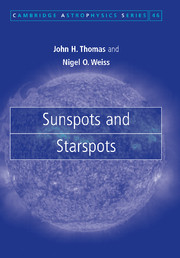Book contents
- Frontmatter
- Contents
- Preface
- 1 The Sun among the stars
- 2 Sunspots and starspots: a historical introduction
- 3 Overall structure of a sunspot
- 4 Fine structure of the umbra
- 5 Fine structure of the penumbra
- 6 Oscillations in sunspots
- 7 Sunspots and active regions
- 8 Magnetic activity in stars
- 9 Starspots
- 10 Solar and stellar activity cycles
- 11 Solar and stellar dynamos
- 12 Solar activity, space weather and climate change
- 13 The way ahead
- Appendix 1 Observing techniques for sunspots
- Appendix 2 Essentials of magnetohydrodynamic theory
- References
- Index
1 - The Sun among the stars
Published online by Cambridge University Press: 28 October 2009
- Frontmatter
- Contents
- Preface
- 1 The Sun among the stars
- 2 Sunspots and starspots: a historical introduction
- 3 Overall structure of a sunspot
- 4 Fine structure of the umbra
- 5 Fine structure of the penumbra
- 6 Oscillations in sunspots
- 7 Sunspots and active regions
- 8 Magnetic activity in stars
- 9 Starspots
- 10 Solar and stellar activity cycles
- 11 Solar and stellar dynamos
- 12 Solar activity, space weather and climate change
- 13 The way ahead
- Appendix 1 Observing techniques for sunspots
- Appendix 2 Essentials of magnetohydrodynamic theory
- References
- Index
Summary
Our Sun is a typical, middle-aged star, but it occupies a special place in astronomy as the only star that we can observe in great detail. Conversely, it is only by studying other stars with different properties, whether of age, mass or angular momentum, that we can fully explain the behaviour of the Sun. This book is concerned with dark spots on the surfaces of the Sun and other stars, which result from the interplay between magnetic fields and convection. In this opening chapter we provide a brief introduction to the properties of these spots, a summary of the important overall properties of the Sun and other stars, and an overview of the topics that will be covered in the remainder of the book.
Sunspots and solar magnetic activity
In this section we introduce a variety of features and phenomena associated with sunspots and solar activity, all of which will be discussed in greater detail in later chapters.
In images of the full solar disc, such as that shown in Figure 1.1, sunspots appear as dark patches at low latitudes. The fact that sunspots are associated with strong magnetic fields emerging through the solar surface is readily apparent in the accompanying magnetogram in Figure 1.1, which shows the strength and polarity of the longitudinal (line-of-sight) magnetic field.
In a close-up image, such as the one in Figure 1.2, a typical sunspot is seen to consist of a dark central region called the umbra surrounded by a less dark, annular region called the penumbra. Some sunspots are remarkably circular and axisymmetric (favourites of theoreticians), while others have very irregular shapes with perhaps only partial penumbrae.
- Type
- Chapter
- Information
- Sunspots and Starspots , pp. 1 - 14Publisher: Cambridge University PressPrint publication year: 2008



